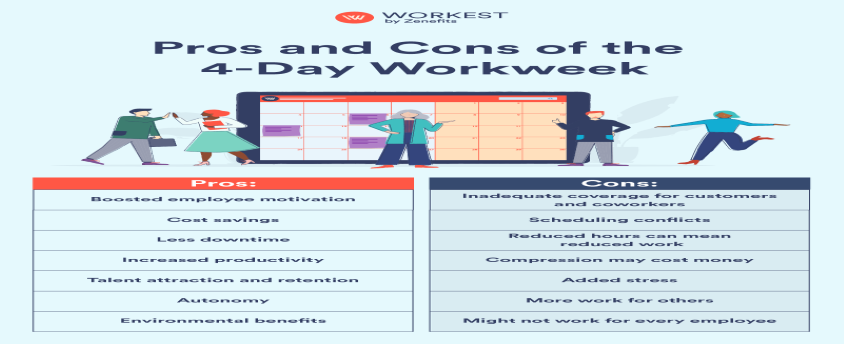Four-day workweek: Analysis
25, Feb 2023

Prelims level : Economy
Mains level : GS-III Economics - Issues relating growth and development, employment
Why in News?
- Much is being made about the major breakthrough in one of the largest-ever experiments with a four-day workweek in Britain. Sixty-one companies were part of the six-month trial and 56 of them have opted to continue with the program, while 18 have made it permanent. 4 Day Week Global trial, overseen by Autonomy, aimed to improve work-life balance by allowing workers to work four days instead of five with the same salary and workload.
Advantages of implementing a four-day workweek:
- Improved Work-life balance: Having a positive work-life balance can also allow professionals to adopt a better attitude about their work, as they can return to their jobs well-rested. This can help employees remain productive and enthusiastic while working.
- Increased job satisfaction: With more free time, employees may feel more satisfied with their jobs and be more engaged at work.
- Reduced absenteeism and turnover: Offering a four-day workweek could make companies more attractive to potential employees, and employees may be less likely to miss work or leave their jobs if they have a better work-life balance.
- Increased productivity: Some studies have shown that shorter workweeks can actually boost productivity, as employees may be more focused and efficient during their work hours.
- Positive environmental impact: Working four days per week decreases the number of times a professional commute to work. This is helpful to the environment, as most vehicles produce emissions that can harm the environment.
Potential disadvantages:
- Limited impact: The benefits of a four-day workweek may be limited in certain industries or job types, such as those that require shift work or have strict deadlines.
- Increased workload: Employees may feel pressure to complete the same amount of work in fewer hours, resulting in an increased workload and potential burnout.
- Reduced productivity: Some employees may find it difficult to maintain focus and productivity over longer workdays. This could lead to a decrease in overall output and quality of work.
- Impact on customer service: If businesses are closed for an extra day each week, it may be more difficult to provide customer service or maintain consistent operating hours.
- Reduced income: With a shorter workweek, employees may see a reduction in their pay, which could be a disadvantage for those who rely on their income to cover living expenses.
Examples of companies/organizations considering a four-day workweek
- Microsoft Japan: In 2019, the tech giant conducted a trial where employees worked a four-day week and saw a 40% increase in productivity.
- Iceland: A number of companies and organizations in Iceland have experimented with shorter workweeks, including the country’s government, which is exploring a four-day workweek for public servants.
- New Zealand: Unilever New Zealand recently announced it would be trialing a four-day workweek for all of its employees, while the country’s prime minister, Jacinda Ardern, has previously spoken in favor of the idea.
- Spain: The government of Spain has proposed a three-year trial of a four-day workweek, with the goal of improving work-life balance and boosting productivity.
Feasibility of Four-day workweek in India’s context:
- Will require a careful analysis: The feasibility and impact of a four-day workweek in India would depend on various factors such as industry type, workforce demographics, and cultural norms. Implementing a four-day workweek in India would require careful analysis of various factors.
- For instance: With the rise of remote work and the increased focus on work-life balance four day week option could be helpful to enhance productivity with improved work life balance in corporate sector.
- Complex regulations: India’s labour laws and regulations are complex and provide significant protections for workers. Any changes to work arrangements, including a four-day workweek, would need to comply with these laws and ensure that employees’ rights and benefits are protected.
- For example: Any reduction in working hours would need to be accompanied by appropriate compensation and benefits to ensure that employees do not suffer financial losses.
- Specific needs of industries: The feasibility of a four-day workweek would depend on the specific needs of different industries.
- For instance: While some knowledge-based sectors may be well-suited to a four-day workweek, industries that require continuous operations or shift work, such as manufacturing or healthcare, may face significant challenges in implementing a shorter workweek.
Conclusion:
- It’s important to carefully consider the potential advantages and disadvantages of a four-day workweek before implementing it in any workplace. The impact may vary depending on the specific work arrangements and the needs of the employees and customers.






